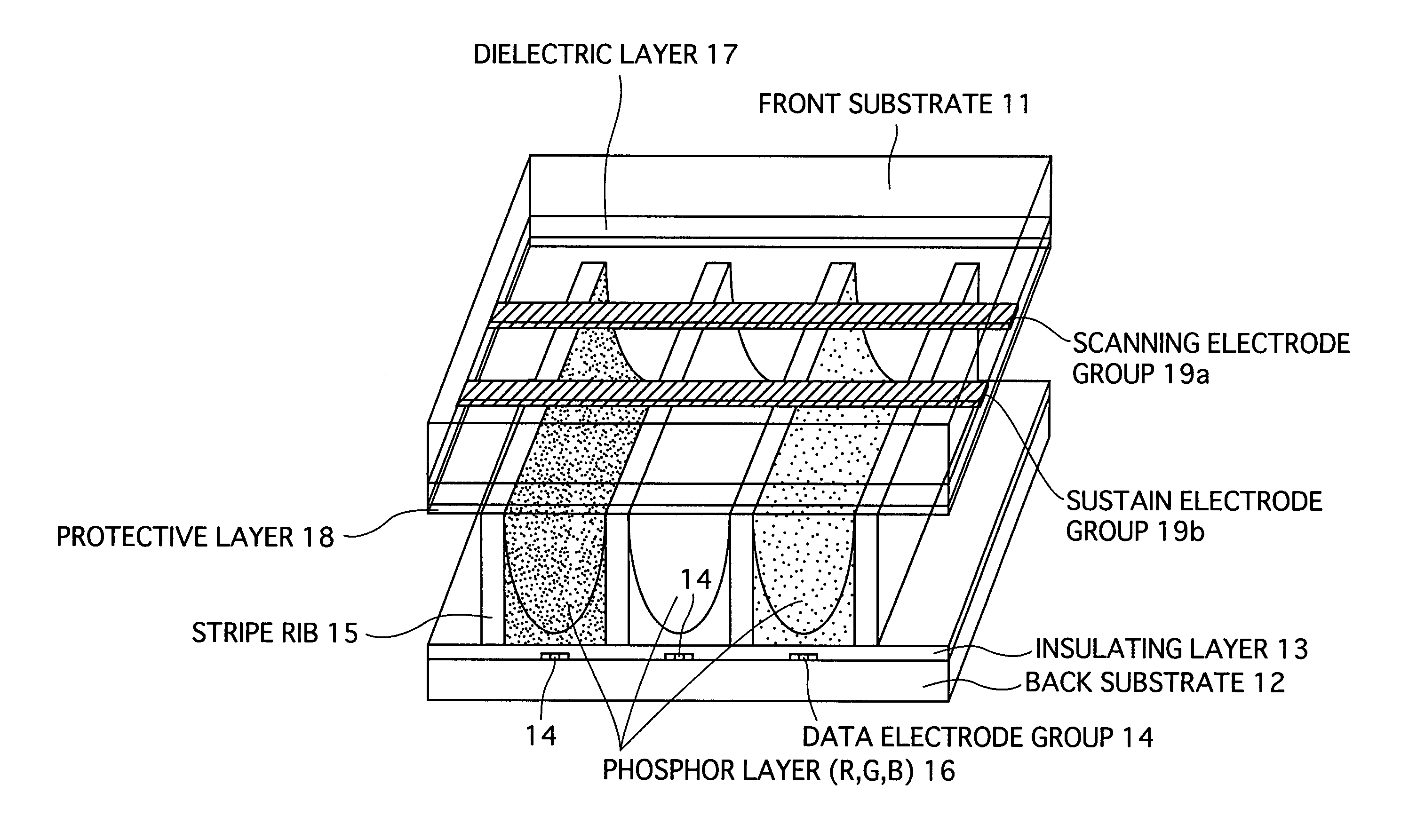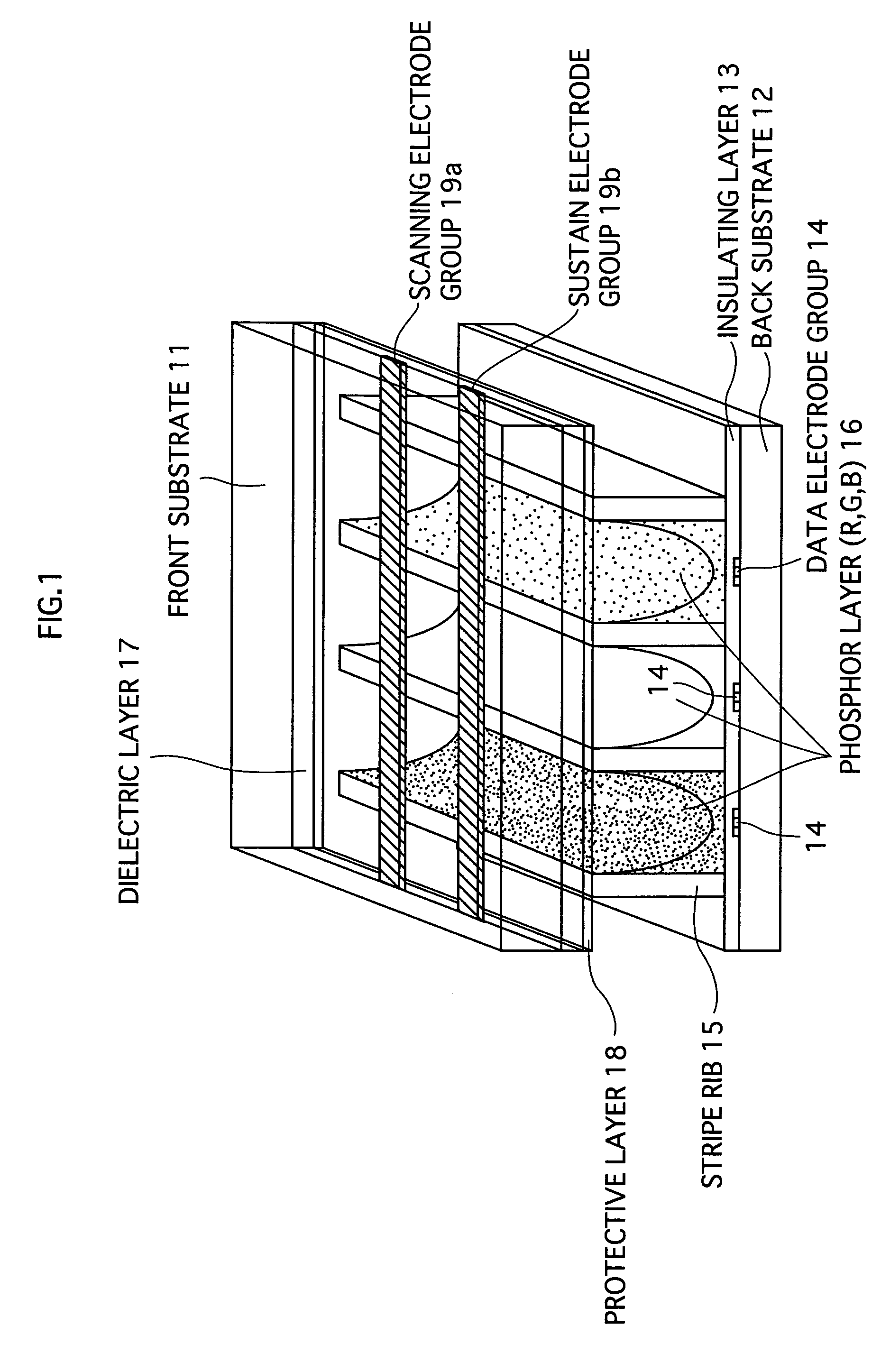Plasma display panel device and its drive method
a technology of plasma display panel and drive method, which is applied in the direction of instruments, gas discharge vessels/containers, and address electrodes. it can solve the problems of significant power consumption challenge to drive the pdp with a small amount of power consumption, and large power consumption of wide transparent electrodes
- Summary
- Abstract
- Description
- Claims
- Application Information
AI Technical Summary
Benefits of technology
Problems solved by technology
Method used
Image
Examples
embodiment 1
[0056]A plasma display apparatus (PDP display apparatus) includes, for example, a PDP and a driving circuit.
[0057]FIG. 1 shows the construction of the PDP in the present embodiment.
[0058]In this PDP, a front substrate 11 and a back substrate 12 are placed in parallel so as to face each other with a space in between. The edges of the substrates are then sealed.
[0059]Scanning electrode group 19a and sustain electrode group 19b are formed in parallel strips on the inward-facing surface of the front substrate 11, forming a plurality of pairs of a scanning electrode and a sustain electrode. The electrode groups 19a and 19b are covered by a dielectric layer 17 composed of lead glass or similar. The surface of the dielectric layer 17 is then covered with a protective layer 18 of magnesium oxide (MgO). A data electrode group 14 is formed in parallel strips so as to be perpendicular to the scanning electrode group 19a, on the inward-facing surface of the back substrate 12. The data electrode...
embodiment 2
[0151]FIG. 12 is a schematic illustration of an electrode pattern in the present embodiment.
[0152]The driving waveform applied to each electrode by the driving circuit in the present embodiment is the same as Embodiment 1. In the present embodiment, the sustain pulse has the two-step rise / fall staircase waveform shown in FIGS. 5A, 5B, and 6. The PDP in the present embodiment has the same construction as that in Embodiment 1, except for the electrode construction as the following description will show.
[0153]In Embodiment 1, each of the electrode groups 19a and 19b has a laminated structure of two layers: a layer of transparent electrodes; and a layer of metal electrodes. Different from this, Embodiment 2 has a split electrode (FE electrode) structure in which each of the electrode groups 19a and 19b is divided into thin line electrodes.
[0154]As shown in FIG. 12, the scanning electrode 19a is composed of three line electrodes 191a–193a that are parallel to each other. Similarly, the s...
example 1
[0213]Example 1 is a PDP with the split electrode structure described in Embodiment 2, and is set as follows: the pixel pitch P=1.08 mm; the main discharge gap G=80 μm; electrode width (L1, L2, L3)=40 μm; and the first electrode gap S1=the second electrode gap S2=70 μm.
[0214]Also, in Example 1, a sustain pulse having two rise steps is used when the PDP is driven.
[0215]FIG. 17A shows the waveform of the sustain pulse and the waveform of the discharge current that is generated when the sustain pulse is applied. As shown in FIG. 17A, the rise start point t2 of the second step precedes the point t5 at which the discharge current is at the maximum. FIG. 17B shows the waveforms of the sustain pulse and the discharge current of a comparative example which is a PDP having the same construction as Example 1 but is different in that the sustain pulse has a simple rectangular waveform.
[0216]As shown in FIG. 17B: the discharge current waveform has a single peak; the discharge light emission end...
PUM
 Login to View More
Login to View More Abstract
Description
Claims
Application Information
 Login to View More
Login to View More - R&D
- Intellectual Property
- Life Sciences
- Materials
- Tech Scout
- Unparalleled Data Quality
- Higher Quality Content
- 60% Fewer Hallucinations
Browse by: Latest US Patents, China's latest patents, Technical Efficacy Thesaurus, Application Domain, Technology Topic, Popular Technical Reports.
© 2025 PatSnap. All rights reserved.Legal|Privacy policy|Modern Slavery Act Transparency Statement|Sitemap|About US| Contact US: help@patsnap.com



